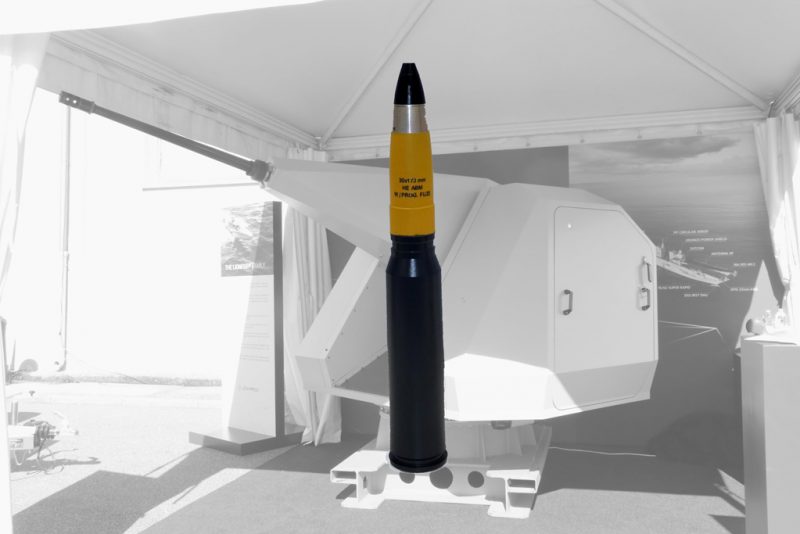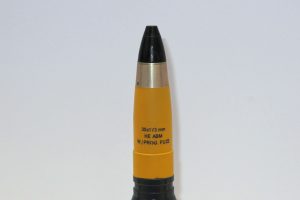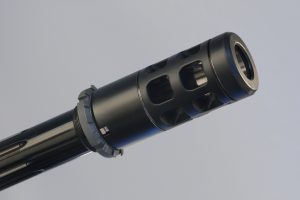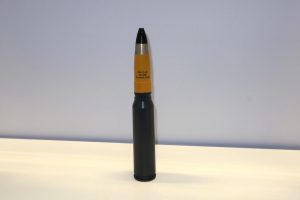Seafuture 2025 – KNDS Ammo Italy details its new 30×173 mm round with programmable fuse and its increasing production capacity
At the La Spezia exhibition Leonardo unveiled the first production Lionfish 30 naval turret, armed with the company new X-Gun. The counter-UAS capability will be provided by the 30×173 HE ABM round, which is under development by KNDS Ammo Italy, this company having provided new details on the round during Seafuture
Introducing an airburst munition into a new gun system means developing two elements, one is the round itself with the fuse, the other is the programming kit. The latter is the one that allows the fuse to receive the right information in order to detonate the round at the optimal moment, when the probability to neutralise the target is maximum. The new KNDS Ammo Italy round is fitted with a programmable time fuse which is programmed thanks to an inductive contactless interface.
The first programming phase is done prior the round is chambered. Here it receives the time of flight based on what has been elaborated by the fire control computer, which considers several factors, such as target distance, point of engagement, wind, temperature, and last but not least muzzle velocity. The V0 considered in the equation is the standard one, therefore it will differ, albeit marginally, from the true muzzle speed. To increase accuracy KNDS Ammo Italy programming kit includes a second programming step, which is done at muzzle brake level.
When the round goes through the two-slot muzzle brake of the Lionfish 30, it measures the time between two gates present in the recoil-reducing device, hence it gets the true V0, which allows refining the time of flight. All the “brain” is included in the round, therefore no more communication is needed, which makes it practically immune to any type of jamming, as the munition is a closed system. Moreover, the muzzle brake is totally passive, hence no power cables are needed. To jam the fuse a very powerful impulse is needed, EDR On-Line understood, and even if this would occur, the original data based on the nominal V0 will remain. Moreover, all programming is done using a proprietary encrypted language since the very beginning of the process.
Coming to the round itself, its body is made of a prefragmented front section, which generates a cone of small fragments optimised to neutralise micro and mini drones. Detonation is initiated at the right distance from the target, thanks to the programming of the fuse, based data provided by the fire control system algorithms, the fragments cone dimensions and the fragments density being optimised for the identified target. The overpressure induced by the explosion also breaks the cylindrical solid steel body of the round; this generates bigger fragments compared to those produced by the pre-fragmented forward section, which spread onto a wider area their speed being the sum of the lateral speed created by the explosion and the forward speed of the round, the bigger mass of these fragments ensuring a higher kinetic energy on the target. These fragments are therefore considered for bigger and harder targets, which gives the KNDS Ammo Italy new 30×173 HE ABM ammunition considerable flexibility. This is even more true as the fuse is not only programmable, but it has a Point Detonation (PD) back-up mode.
The programming kit configuration is frozen, and the system is currently undergoing the qualification process, which should be concluded by November 2025. As for the round itself, the qualification process should start in 2026 and should last less than one year.
The conflict in Ukraine highlighted the need to increase ammunition production. The new round was already designed to favour mass production, the chief engineer leading the design phase being the same person that will be responsible for industrialisation. On the other hand, the KNDS group invested on the Colleferro facility, home of KNDS Ammo Italy. Explosive loading capacity was increased from 2 tonnes to over 3.5 tonnes per day, while the fuse production capacity is now of around 180,000-200,000 items per year, an increase of 30-40%.
Photos by P. Valpolini







